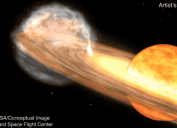"Naked-Eye" Comet Approaching Earth May Become Brighter Than the Stars
The icy rock has been in orbit for 80,000 years.

This year has brought stargazers a total solar eclipse, supermoons, active meteor showers, and who could forget the beautiful Northern Lights display that occurred over Mother's Day weekend? And it appears the celestial heavens aren't letting up anytime soon, as a "naked-eye" comet as bright as Venus is anticipated to magnify Earth's sky later this fall, Space reports.
Come Oct. 12, 2024, scientists predict that comet C/2023 A3 (also called Tsuchinshan-ATLAS) will be just 44 million miles from Earth, making it one of the brightest figures in our night sky.
RELATED: New Star Will "Explode" in the Night Sky—How to See the "Once-in-a-Lifetime" Event.
Tsuchinshan-ATLAS was first discovered in 2023 by the Asteroid Terrestrial-impact Last Alert System (ATLAS) in South Africa. It was originally believed to be an asteroid, but a report from the Purple Mountain Observatory in Nanjing, China has since determined the soaring snowball to be an incoming comet. But while the comet is new to astronomers, it's actually quite old.
According to Forbes, Tsuchinshan-ATLAS is what experts call a "long-period comet" because it has been orbiting for over 80,000 years. It comes from the Oort Cloud, whose icy bodies can take upwards of 200 years to orbit the sun, per the National Aeronautics and Space Administration (NASA). Oort Cloud comets are also famously known for their mountainous size.
In Feb. 2023, Tsuchinshan-ATLAS was spotted past Jupiter, about 680 million miles from the sun. However, Space reports that by Sept. 2024, that distance is expected to dwindle to just 36 million miles—a seismic shift, considering Tsuchinshan-ATLAS will be in line with Mercury, the closest planet to the sun.
But that's not all. Tsuchinshan-ATLAS, in all its icy, brilliant glory, will be visible from Earth on Oct. 12, 2024. It's expected to pass just 44 million miles from Earth. To put that in perspective, Venus is 160 million miles away from Earth yet is considered Earth's closest planetary neighbor.
"These figures suggest that the comet might brighten to second or possibly even first magnitude and could develop a notable tail that could make for an eye-catching sight in the western evening sky during mid-October 2024," explains Space.
Tsuchinshan-ATLAS follows 2023's "Great Green Comet" and the foreboding "Devil Comet," which graced Earth's atmosphere earlier this year. Despite their mysterious nicknames, neither comet displayed a beaming spectacle for astrophiles. However, a better outcome is expected for Tsuchinshan-ATLAS.
Should Tsuchinshan-ATLAS make its way as planned, those in the Northern Hemisphere will be able to catch glimpses of the flying rock between late September and mid-October. If you're traveling to Australia, New Zealand, or South America this summer, look upwards as Tsuchinshan-ATLAS may be visible in the early morning hours before sunrise.
However, there is a chance that Tsuchinshan-ATLAS' "brightening trend" will suddenly slow. If that does happen, experts say, "all bets for a good show are off." Only time will tell whether Tsuchinshan-ATLAS has enough power to "evolve into an eye-catching sight" come autumn.
- Source: NASA: Oort Cloud





















